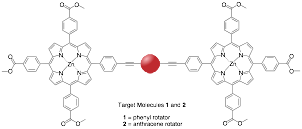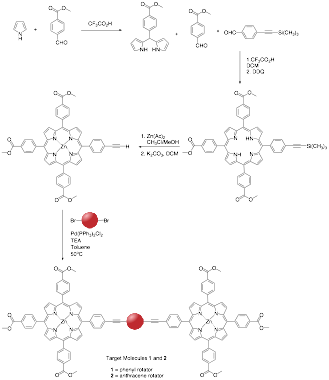57th Annual Report on Research 2012 Under Sponsorship of the ACS Petroleum Research Fund
Reports: UNI1051012-UNI10: Synthesis of New Tunable Porous Coordination Materials to Demonstrate Geared Motion in Solid-State Materials
Stephanie L. Gould, PhD, Austin College
Tunable Molecular Gears in the Solid-State
This ACS PRF funded proposal aims to utilize supramolecular interactions to provide a template for organization and function of geared molecular rotors. The PI originally proposed the creation of a porous coordination material to facilitate the orientation of rotational components to demonstrate gyroscopic and correlated motions in the solid state. These studies are to be done primarily in three-dimensional crystalline aggregates for which no geared motion has been previously reported to-date. The overall proposed structure is illustrated in Figure 1.
Figure 1. Proposed Stacked Rotor, Porphyrins (purple diamonds) are covalently bonded to rotator components (red circles pillared by bidentate ligands (orange ovals).
During the first year of funding from the ACS PRF, two monomers, 1 and 2, have been successfully synthesized and characterized. Work done in the lab prior to this funding had limited success because of a complicated purification step. Within the first six months of this grant Raven Clark and Matthew Moore, both undergraduate researchers, retooled the porphyrin design to not have the purification complications (new target molecules shown in Figure 2).
Figure 2. Target Molecules 1 and 2
Three Austin College undergraduate researchers, Brian Clinton, Ashley Hellman and Stephanie Lee, worked full-time in the research lab during the summer 2012 for eight weeks to synthesize target molecules 1 and 2. The synthetic pathway used is show in Figure 3 highlighting the key Sonogashira coupling that allows for modification of the rotator, shown as a red ball. Three students, Ms. Clark, Ms. Hellman and Ms. Lee will continue to synthesis additional material and begin crystallization studies with and without ligands.
Figure 3. Condensed Synthetic Pathway to the Formation of Target Molecules 1 and 2
Development of new Dyes for use in Dye-Sensitized Solar Cells
In collaboration with the Dr. Bradley Smucker at Austin College, the PI has been able to utilize the excellent photochromic properties of porphyrins with the luminescent properties of terpyridinyl platinum complexes to form a broad-spectrum dye for use in a dye-sensitized solar cell. The chemical structure of the target molecule is shown in Figure 4.
Figure 4. Chemical Structure of Terpyridine Platinium capped Porphyrin Dye
Dr. Smucker and the PI, Dr. Gould, co-advised an academic year undergraduate researcher, Jon Payne, and a summer undergraduate research student, Amy Harvey, working on this project. Funding for Ms. Harvey's stipend was paid by Austin College and funding for supplies was shared between this PRF grant and Austin College. Significant progress was made during the summer, both a model capped 1,4-diethynylbenzene complex and the desired porphyrin dye were synthesized. Luminescent properties of the porphyrin dye are being studied with preliminary data showing the formation of a broad-spectrum absorption including an absorption band not seen in the individual parts of the molecules spectra. This new research is very promising for the PI and will be continued into the future.
Impact of Funding on Undergraduate Student Research
Conducting research has a huge impact on student outcomes and student learning. Though long-term tracking within the Chemistry Department at Austin College, we can say that our graduates indicate that research opportunities by and far have the greatest impact on them. Students involved in research develop their critical thinking and problem solving skills, self-confidence in their ability to do science along with increased communication skills.
This ACS-PRF funding has triggered the expansion of the undergraduate research program at Austin College. The Chemistry Department received additional funding from Austin College allowing all PI's the ability to mentor three undergraduate researchers during the summer.
In the laboratory, students gained valuable experiences performing synthesis, characterization and study of materials throughout the grant period. Characterization of materials was done by solution NMR, UV-vis absorption spectroscopy, and IR spectroscopy. The students are beginning to learn about crystallization techniques and will have the opportunity to learn how to interpret the data once it is obtained.
Students dove into the primary literature about their research projects and meet regularly with the PI and the group to discuss research topics. Each student will present their work in a seminar format during the academic year and has written a full research paper. The results from research done with this funding will be presented in two locations during the 2012/2013 academic-year. Each summer researcher (Mr. Clinton, Ms. Harvey, Ms. Hellman, and Ms. Lee) have submitted abstracts and been accepted to present posters of their research at the 2012 Rocky Mountain Regional American Chemical Society Meeting. Ms. Clark has submitted an abstract to the spring National American Chemical Society Meeting in New Orleans and Mr. Moore will also submit to that meeting in the next two weeks. Austin College is funding the travel to the regional meeting and this grant along with Austin College will fund travel to the national meeting for the PI and two students.














